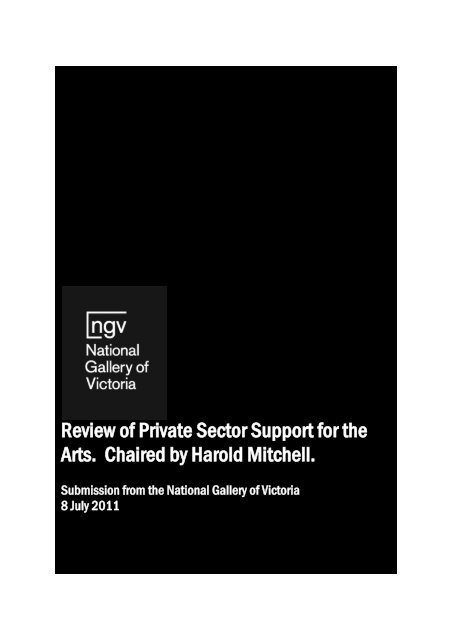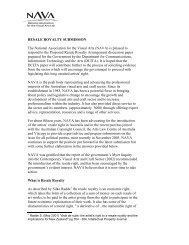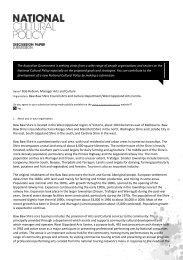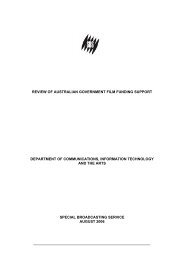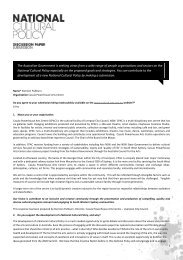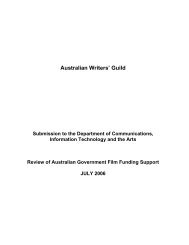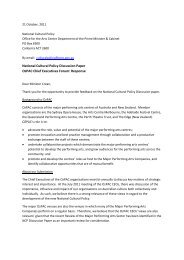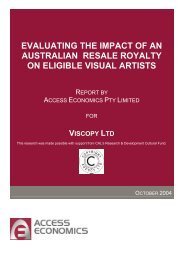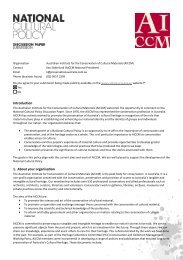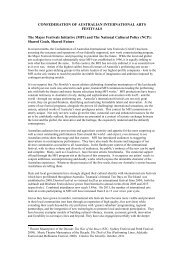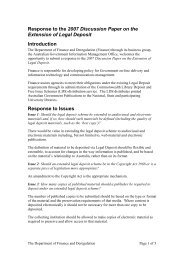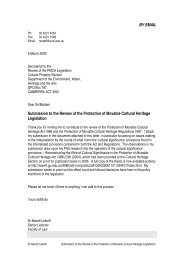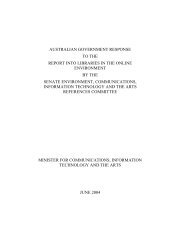PDF (182 KB)
PDF (182 KB)
PDF (182 KB)
Create successful ePaper yourself
Turn your PDF publications into a flip-book with our unique Google optimized e-Paper software.
Review of Private Sector Support for theArts. Chaired by Harold Mitchell.Submission from the National Gallery of Victoria8 July 2011
Review of Private Sector Support for the ArtsBACKGROUNDThe National Gallery of Victoria (NGV) is pleased to provide this submission as part of theFederal Arts Minister’s review of private sector support for the arts.In our response we have considered private sector support in terms of both the financialsupport the NGV receives for its acquisitions of works of art, as well as the support it receiveswhich assists in the funding and running of its operations in general, including its exhibitionsprograms.Private sector support, overwhelmingly in the form of individual benefaction, has long been theprimary source of the NGV’s art acquisition funding.However, the NGV now also relies significantly upon corporate and individual private sectorfinancial support to fund capital improvement works, such as a new gallery space, and to fundits exhibition program, as well as volunteers to augment paid staff roles; all of which contributeto the NGV’s annual financial operating performance.This submission is organised in two sections, broadly consistent with the components of theterms of reference of the review.1. Perspectives on current Australian Government arrangements for encouraging privatesector support of the arts2. A brief and preliminary outline of a set of ideas which may directly or indirectlycontribute to greater private sector support of institutions such as the NGV (or in someinstances, DGRs more broadly)In respect of point 2 above, we have assumed a broad interpretation of the scope of this reviewand included thoughts on a relatively wide range of topics, on the basis that an expansive andcreative collective set of suggestions should be the starting point, from which a more refinedresponse from the review panel can be developed. The NGV has not undertaken detailedresearch in support of all of these ideas, but offers perspectives informed by its own experience,acknowledging that not all the ideas contained in this section may be accepted.7 July 2011 2
Review of Private Sector Support for the ArtsEXECUTIVE SUMMARYThe key points, suggestions and recommendations elaborated on in the detail of this documentare summarised below.1. Current Australian Government ArrangementsWe are very limited users and beneficiaries of ABAF or the Australia Council andsupport a review of these bodies and federal arts funding more broadly, mostparticularly in relation to their potential to support public art museumsWe are a large user and beneficiary of the Cultural Gifts Program and it has served uswell. Suggestions for enhancing this program should be considered with this ascontextPublic and Private Ancillary Funds typically do not provide funding to the NGV becauseof a belief that the NGV is ineligible. Clarification and confirmation of eligibility isrequired and this needs to be widely communicated2. Possible enhancements or new modelsProviding more explicit recognition and celebration of donors to create communityincentives and leadership examples of philanthropy, as a tool to move the Australian‘cultural expectation’ of philanthropy and aggregate levels of giving closer to that ofother countries such as the USAOffering enhanced and differentiated financial incentives to encourage individualdonations at all levels; especially for funding endowmentsAdvocating and creating additional incentives for workplace giving which remainsunder-penetrated in AustraliaProviding additional taxation benefits to corporate sponsors, to differentiatesponsorship from other business expenses and discourage related competingcorporate activities that may be inconsistent with arts institutions’ objectivesProviding additional tax benefits, for a limited time, to businesses to encourage one offdonations of selected important works of art from corporate collectionsCreating additional incentives for volunteeringRemoving or clarifying any perceived impediments to giving to the extent they exist,including any lack of awareness associated with tax incentivesProviding funding support for specific domestic and outbound international exhibitionsProviding Federal Government immunity from seizure guarantees to ensure Australianart museums are able to borrow international works and import exhibitions and therebymaximise sponsorship and visitor outcomesEnsuring ATO and Federal Government objectives and policies are alignedProviding financial support for digitisation of individual collections to enable newcommercial opportunities to be accessedRemoving imbalances in relation to employee rewards (PBIs vs. other DGRs)Providing access to funding for fundraisers to enable arts institutions to continue topursue their fundraising goals, notwithstanding operating budget constraintsAddressing unintended issues in relation to the application of ACCC anti competitionrulesEstablishing a National Heritage Fund, the remit of which would include assistance inthe acquisition and conservation of Australia’s national cultural heritageEstablishing a national lottery with surplus funds applied to the arts7 July 2011 3
Review of Private Sector Support for the ArtsDETAILED RESPONSETerms of Reference1. Examine current Australian Government arrangements for encouraging private sectorsupport for the arts in Australia and consider any potential enhancements to existingAustralian Government measures.Organisational fundingABaF and the Australia CouncilThe NGV has limited involvement with ABaF and the Australia Council and derives little or nobenefit from either organisation. On rare occasions, the NGV has benefited from fundingprovided through the Australia Council for touring exhibitions.In our opinion, ABaF’s support of the visual arts is significantly lower than its support of theperforming arts. There is a view that ABaF does not provide value to the visual arts sector, andthe NGV would support this view.Furthermore, through the establishment of its own programs, ABaF directly competes with artsorganisations such as the NGV for sponsorship (e.g. ABaF awards are sponsored by, amongothers, Qantas, Goldman Sachs and Woodside; many of whom are, or could be, artsorganisations sponsors). In the context of an increasingly competitive and difficult sponsorshipenvironment, discussed in more detail below, this not helpful to the NGV and arguably counterto the policy objective of promoting private sector support of the arts.Other organisational funding perspectivesWe make the following additional observations in regards to current Federal Governmentfunding arrangements.There is a perceived inconsistency in Federal Government funding of the performing arts versusthe visual arts, with a bias towards the former. For example, we understand that state basedperforming arts entities such as the Melbourne Symphony Orchestra receive half their fundingfrom the Federal Government, yet the NGV and other state based arts museums, which attracthuge audiences and generate economic benefit, receive no funding. Addressing this would bea positive outcome of this review.It could be argued that the level and nature of federal funding of the state based art museumsrelative to the National Gallery of Australia (NGA) should also be examined, together with theNGA’s mission, relative to the ‘sub national’ and state based art museums, to assess theequity, efficiency and competitive dynamic currently at work. The Federal Government, throughstate based tax revenues generously funds not only the NGA’s operating costs, but also itsacquisitions and its major paid exhibitions. The state based museums receive no such federalfunding for any of these activities, and no regular funding for acquisitions from any governmentsource. We would argue that the generous funding of the NGA be also considered for the statebased museums, where existing state based funding is not in place. (E.g. acquisition funding.)For the reasons articulated above, the NGV would support a further review of the objectives,existing organisational administrative efficacy and allocation of federal funding of the arts, with7 July 2011 4
Review of Private Sector Support for the Artsleft by the annual State Government operating grant. The tax-deductible status of this privatesector support is undoubtedly key to its provision.Notwithstanding this position, there are significant challenges (and risks) inherent in the NGV’sincreasing reliance on private sector support and we welcome this review and furtherexploration of models that support our financial sustainability and future obligations andaspirations, as well as those of the sector at large.We have included a range of perspectives in this section of our submission, for the reasonsoutlined at the beginning of this document, acknowledging that not all may be accepted. Wehave organised these ideas into the following two categories:1. Ways in which the Federal Government could encourage direct private sector support ofthe arts or the not for profit sector more broadly2. Ways in which the Federal Government through its intervention or funding could assistinstitutions such as the NGV operate more efficiently and effectively, including in theirown pursuit of private sector support1. Ways in which the Federal Government could encourage direct private sector support of thearts or the not for profit sector more broadlyThe World Giving Index 2010, cited in the discussion paper which accompanied the terms ofreference for this review, lists Australia and New Zealand as the most ‘giving’ countries in theworld in terms of gifting money, time (volunteering) and helping a stranger. However, as hasbeen widely reported, Australian private sector philanthropy as defined by gifts of cash or cashequivalents is relatively narrowly based and in aggregate significantly lags many other peernations as a percentage of income or investable assets; most notably the USA. According tothe Petre Foundation, (2008 research), wealthy Australians give less than 0.5% on an incomebasis, compared to almost 4% in the USA; an eight fold difference. In the USA, giving, andalignment with a not for profit cause, is an expectation, not an exception, in particular, forbusiness and community leaders. It is an essential aspect of the cultural fabric of their nation.There are without doubt many legacy reasons for these differences between Australia and theUSA, and achieving meaningful and sustainable change will take time. However, this is thefundamental issue and it must be addressed in a more systematic, creative way, with FederalGovernment leadership, than has been the case to date.The NGV would support further research into this issue to determine community andprospective donors’ views on why individuals do or do not donate, impediments to makingdonations and suggestions for driving greater levels of private sector giving to the arts or morebroadly.In our view some considerations might include:Providing more explicit visibility, recognition and celebration of philanthropy and donors at alllevels, but particularly at the highest level.Better recognition and celebration of individual acts of philanthropy will serve to heightencommunity awareness of philanthropy, move the cultural philanthropic ‘expectation’ in the rightdirection, and provide leadership examples for others to follow.Australia should celebrate its major philanthropists publicly and perpetuate their name in thesame way we recognise iconic sports people and politicians. The responsibility for this rests7 July 2011 6
Review of Private Sector Support for the Artswith all levels of government, but we would argue that it is incumbent on the FederalGovernment to lead the way. Potential opportunities are suggested below.We would encourage the government to create an award to recognise great examplesof benefaction, such as a ‘Philanthropist of the Year’, perhaps included in the AustraliaDay honours alongside the other Australian of the Year awards. This may require theFederal Government to more overtly recognise individuals who operate at a state levelThere is a latent opportunity to name infrastructure in honour of philanthropists. Atpresent, by and large, major donors’ names only appear in direct association with thegifts they have made to a particular institution. E.g. the BBDO Clemenger Auditoriumat the NGV. There are very few examples of infrastructure (roads, bridges, parks,schools etc) named in honour of our greatest contemporary community members andbenefactors, unlike some other countries and unlike sports people (E.g. the Rod LaverArena) and politicians (E.g. the Harold Holt Swim Centre). In Canberra, we understandroads are named posthumously after successful individuals in their field, whichsomewhat defeats the purpose. We would encourage the Government to thinkcreatively about how it can leverage its own portfolio of assets as part of a coordinatedstrategy across all levels of government to better recognise and celebrate privatebenefaction (and other important community contributions), and in doing so createnew incentives for giving, and set examples for the broader community to aspire to andfollowThere may be a logic for developing a cadre of high profile philanthropy ‘ambassadors’whose role would be to advocate and promote philanthropy across the community.This would likely include individuals from a diverse range of socio-demographic andethnic backgrounds, reflective of both our community at large and the opportunity tobroaden the base from which Australian philanthropy is drawn in years to comeOffering enhanced financial incentives to encourage individual donationsThe existing taxation regime as it applies to donations of cash or works of art has served theNGV relatively well. The NGV is recognised as one of the world’s finest art galleries andindisputably as having the finest general collection of any art museum in Australia. This isoverwhelmingly due, over the course of its entire 150 year history, to the generosity ofgenerations of leading Victorians.However, this reputation is at risk, as the NGV is increasingly unable to compete for thepurchase of significant works of art either nationally or on the global stage. Our endowmentand annual fund raising efforts are insufficient to fund our collecting aspirations- andcommunity and legislative obligations. Yet without continuous growth and renewal, the NGVrisks becoming a static museum.As such, the NGV would welcome further federal tax based initiatives aimed at directly orindirectly enhancing the NGV’s purchasing power through their ability to generate higher levelsof giving. These might include;Enhanced tax deductibility for donations (e.g. greater than 100% of gift value)o This could apply to cash only, or to cash and works of art; however, the latterrequires further analysis to ensure any undesired consequences areminimised and do not outweigh the benefits (e.g. impacts on sale prices of art,creation of incentives and workloads in relation to proposed donations ofworks unsuitable for accessioning). Furthermore, recent changes to DIY7 July 2011 7
Review of Private Sector Support for the Artssuperannuation rules as they apply to art as an investment class may tend, atthe margin, to increase the volume of gifts of works of arto These additional benefits could be temporary or permanent, capped oruncappedConsideration of incentives, consistent with the points above, regarding recognition,for donors to identify themselves rather than remain anonymous, on the basis thatvisible giving and leadership encourages others to give, and will contribute to thedevelopment of a philanthropic culture amongst Australians. The idea of taxincentives has been raised in this regard; however, we would want to better understandany negative or unintended consequences of this idea before offering support for it. Itmay be argued that it is primarily the institution’s role, not the Government’s toencourage donors to identify themselves, and we would certainly not want to createdisincentives for those donors who choose to remain anonymousBroadening the eligibility criteria for tax deductible giving of works of art, e.g.o Allowing a work of art to be gifted on a ‘part sale/part gift’ basis, which weunderstand is possible in some other countries. Currently gifts of this natureare treated as ‘discounted’ which has the effect of impacting the tax positionof the donorProviding tax incentives for lending of important works of art on a long term basis.There are clearly large quantities of museum quality art that are not accessible to thepublic, by virtue of their private ownership, institutions’ traditional focus on collecting(acquiring) and the lack of any financial incentive to lend such works. We wouldsupport an assessment of the benefits of providing some form of ‘public access’deduction to private sector donors (potentially including corporates) in return forforegoing rights to these works for a period of time. This might be a step towardsgifting the works in the fullness of time in some cases. A scheme such as this wouldincur additional costs for institutions in respect of cataloguing, insurance etc whichcould be netted from the deduction, or funded separately. This suggests a schemesuch as this would require criteria which limited its scope to only the most importantworks held in private collections and offered for considerable or regular periods of timeRemoving the tax disincentive for giving via a bequest, perhaps through the provisionof tax benefits to heirs, to provide additional giving incentives to the increasingly large,older segment of the community contemplating their will and the role a bequest mayplayAnd perhaps most importantly, providing additional taxation benefits for donationsspecifically directed to art museum endowment funds. Endowment funds in Australiaare tiny when compared with the US. It is the purchasing power of these funds thatenables institutions to make sensible and strategic acquisition plans, and to be selfreliant,rather than depending substantially on reactive and short-term fundraising topurchase an item listed for auction. However, there is a general preference amongAustralian donors to assist in funding a specific work, which has the effect ofperpetuating a cycle of short-term fundraising efforts. To the extent differentialtaxation benefits might serve to rebalance this situation, this is something that shouldbe explored as a priorityPotentially linked to these individual tax based incentives, the Federal Government mightconsider the creation of a matching gift fund for a limited time to promote individualbenefaction.A fund such as this could be capped or uncapped. It could also be applied using asliding scale mechanism to further encourage larger donations, or provided or further7 July 2011 8
Review of Private Sector Support for the ArtsFinally, in regards to sponsorship, there is movement by several corporates to create their ownevents (in the arts or elsewhere), rather than to sponsor an existing provider. This isunderstandable to the extent that it provides the company with more control, an ability to sellbroadcast rights etc. However, if this trend continues, it will increasingly be at the expense ofexisting arts institutions and programs.For these reasons we would encourage consideration of additional tax benefits to the corporatesector for direct cash sponsorship of institutions such as the NGV, on the basis that it drivessponsorship mix changes or additional spend (i.e. it meets an ‘additionality’ test).Providing additional tax benefits, for a limited time, to businesses to encourage one offdonations of works of art from corporate collectionsThere remains a large amount of highly desirable works of art housed in the corporatecollections of Australian companies. In recent times, donating these works has become a moredifficult and sensitive proposition on the basis that these works represent shareholders’ fundsand it is difficult to justify making such donations on behalf of shareholders. The last majorcorporate donations to the NGV were around ten years ago. (Rio Tinto: Fred Williams’ PilbaraSeries; Alcoa: Sidney Nolan, Landscape (Salt Lake); and The Shell Collection of ContemporaryArt.)Introducing a one off window of time whereby a corporation may qualify for a tax deduction ofgreater than 100% for important works (or works over a certain threshold value) donated to artmuseums (and agreed to be accessioned, or able to be on sold), may provide the catalyst thatis needed to prompt a wave of important corporate gifts, legitimised in shareholders’ eyes, andperhaps advocated for by them, due to the one off nature of the event and the opportunity tocrystallise an attractive tax deduction which will not remain available, as well as free up cashfrom non-core assets. This will enable an additional component of Australia’s rich art history tobe able to be widely viewed by the public, possibly with positive benefits for the most generousof the companies in question as well.Creating additional incentives for volunteeringAt present, the giving of services is under-recognised and not tax deductible. We would supportfurther recognition of the efforts of volunteers, in the same vein as we endorse higher levels ofrecognition and celebration of philanthropy. We acknowledge the challenges inherent inrecognising the value of individual gifts of service, but would support, as part of the AustralianGovernment’s commitment to delivering a National Volunteering Strategy in 2011, furtheranalysis into any means by which those who volunteer their time, might in a limited way beentitled to a financial benefit in return for their activities, to create incentives for furthervolunteerism. (Not at the expense of the overarching altruistic notion which should remain atthe heart of volunteering however.) This might include a review of other countries’ approachesto this issue. For example, is it feasible that a gift of time, with the equivalent of a groupcertificate could be considered as a personal expense, or opportunity cost, with a valueattached to it, offset against income up to a certain level, or generate a cash rebate for lowincomeearners? These measures would have the effect of providing additional or cheaperresourcing for organisations in areas such as fund raising.An additional consideration of the National Volunteering Strategy might be the‘professionalisation’ of volunteering, through the development of a training and accreditation7 July 2011 10
Review of Private Sector Support for the Artsbody. Not only would this enhance the quality and effectiveness of volunteers, it would providethem with a more tangible ‘qualification’ and a level of community status and recognition.Removing any perceived impediments to givingWe do not know the degree to which private sector giving in some segments of the community islimited or avoided due to perceived complications or lack of awareness of the tax rules andbenefits; as opposed to a lack of incentive. But we suspect for example that the giving optionsand associated tax incentives and deductions available for gifts under the Cultural GiftsProgram are not as widely understood by potential donors as they might be, in part becausethey are relatively passively promoted. To the extent any analysis indicated this to be the case;clearly this represents an opportunity, for government as well as arts institutions themselves.Furthermore, the recent changes to DIY superannuation rules as they apply to art as an eligiblesuperannuation investment class suggest more art may be disposed of (sold or gifted) byexisting investors. This adds to the argument for ensuring adequate awareness of the CulturalGifts Program, over the next few years in particular. This might, for example, include working toensure the eligibility criteria for taxation benefits associated with private sector giving weremade as simple as possible, and the development of a proactive awareness program,potentially under the stewardship of a new body comprised of donors, government and taxofficials and private sector advisors (lawyers, financial planners and accountants).There is also an argument, raised earlier in this document, that the tax rules as they currentlyapply to bequests may discourage individuals to include a bequest in their will. Revising theserules such that heirs are not unduly penalised, and communicating this amendment as part ofthis program, may be another possibility.2. Ways in which the Federal Government through its intervention can assist institutions suchas the NGV operate more efficiently and effectively in their own pursuit of private sectorsupportProvision of Federal Government funding support for specific domestic exhibitionsExhibition sponsorship funding is contingent on the nature of the proposed exhibition andvisitation estimates. The NGV aspires to present a larger number of major contemporaryAustralian and Asian exhibitions; however, in our experience they are often not commerciallyviable; required visitation levels being driven through free entry. Sourcing the necessaryfunding from sponsors alone (rather than ticket sales) is often not feasible. Hence a stalematedevelops, occasionally broken by state government funding.Therefore, the Government might consider encouraging the delivery of these types of exhibitionsvia the creation of a national fund whose objective might for example be the funding ofexhibitions of contemporary Australian art. This would have the benefit of supporting thecareers of Australian artists, as well as the presenting institution and the community, withindirect benefits flowing back to Government over time.Provision of Federal Government support of outbound international exhibitions7 July 2011 11
Review of Private Sector Support for the ArtsLocally sourced and curated exhibitions that travel to foreign institutions play an important rolein supporting Australia’s international cultural and tourism objectives, promoting our heritage,natural beauty, creativity and artists (as demonstrated by Australia’s participation at the VeniceBiennale). These exhibitions are expensive to mount, and typically require ‘outgoing’sponsorship support to implement. This funding and sponsorship support comes at theexpense of, or must be weighed against, funding and sponsorship support of local exhibitions,with potential implications for the quality and quantity of these local exhibitions. In addition, inour experience, overseas institutions are often reluctant to take the financial risk on an‘imported’ Australian exhibition, even though their professional staff may admire Australian art.Federal Government support or subsidisation of outbound exhibitions meeting a set of criteria,would therefore benefit both the arts sector’s and the Federal Government’s internationalobjectives, as well as our local art exhibiting aspirations, by directing greater private sectorfunding and sponsorship towards local exhibitions and local visitors. Over time, this could beexpected to drive deeper community engagement with and support of the sector as well asgreater international appreciation for Australian art.Provision of Federal Government ‘Immunity from Seizure’ guaranteesAustralia lags much of the rest of the world, including the UK, USA and much of Europe inrelation to the provision by national governments of immunity from seizure guarantees forincoming loans of works of art. This issue directly affects the NGV’s ability to secure loans ofimportant specific works of art which can be critical to the content of a temporary exhibition,and potentially our ability to compete for entire ‘pre-packaged’ touring exhibitions from manycountries including Russia, much of Europe and increasingly, Asia. As a result our negotiatingposition is diluted, and our exhibition offering is at times limited or compromised, which in turnmay have a negative impact on our ability to attract visitors, sponsors and even donors.Without change, over time, Australia’s art museums will slip down the global exhibitionrankings. Although this matter may arguably be outside the scope of this review, we urge theFederal Government to address this issue as a matter of priority. Without indemnity fromseizure legislation, it is undeniably the case that Australians will miss out on viewing andengaging with major works and exhibitions in years to come.Ensuring ATO and Federal government objectives and policies are alignedAt present, there is very little opportunity to provide any benefit whatsoever to a donor withoutcalling into question the eligibility of the gift for tax relief. (However, we may provide benefits toa prospect who has not yet donated.) We do not believe this is a major impediment to giving ingeneral, but to the extent there is an opportunity to ensure the ATO rules are consistent with theFederal Government’s intent (for example tying the notion of materiality to the gift size moreclearly) we would encourage such a review. This may allow the NGV to distinguish, at themargin, between different donor types, and avoid the occasional awkwardness with majordonors that comes with the strict interpretation of this rule.Provision of financial support for the digitisation of the collectionA major challenge and opportunity confronting many visual arts institutions is the digitisation oftheir collections. This is time consuming and expensive; in internal resources involved in theverification of extensive catalogue records and imaging all works, as well as in seeking andpaying for copyright; and for many, a work in progress. However, once complete there is anever-growing set of e-commerce related opportunities to monetise these ‘assets’. In addition,7 July 2011 12
Review of Private Sector Support for the Artsthis process will further contribute to the evolving ‘borderless’ nature of our state based artmuseums; thereby providing wider access to all Australians and the international community.An initiative which supported the costs of this endeavour, for example via direct funding supportor tax based incentives (e.g. to the owners of copyright, at least within Australia) would enableart museums to better access the commercial opportunities implied by digitisation, with theassociated prospect of a high return on investment for funding of this nature. Funding givendirectly to an art museum will provide more far reaching and efficient results, rather than givingto a centralised agency, as was previously the case, with the (now defunct) Collections Councilof Australia.Removing imbalances in relation to DGR employee rewardsCertain not for profit institutions are classified as Public Benevolent Institutions (PBI). PBIsoffer attractive FBT relief to staff, regardless of their salary (e.g. doctors and cleaners areequally entitled). Arts related NFPs do not meet the eligibility criteria. However, they typicallycompete for staff with PBIs, for example in the fundraising arena. The result is that artsinstitutions find it considerably harder to attract and retain staff with certain skills than wouldotherwise be the case. Levelling this playing field, somewhat akin to the comments in relationto TCC eligibility above, would be a positive move for the arts sector.Providing funding for fundraisersFundraisers are typically funded out of art museums’ operating budgets, not from funds raised.As a result, fundraiser FTE and compensation is typically subject to the same significant budgetconstraints that apply to the rest of the organisation. Is there an ‘efficiency argument’ for theFederal Government ‘funding the fundraisers’ on the basis that each fundraiser generates amultiple of their compensation in new funds raised for their employing organisation?Addressing unintended issues in the application of ACCC rulesAt present, the ACCC takes a strict view of any apparent anti competitive behaviour in the artauction market- as in general it should. However, when this extends to potentially prohibitingdirectors of public art museums from making purchasing decisions in relation to art works ofnational significance, that are informed by other public art museums’ art acquisition strategy,(which may be seen as colluding), we ask whether this is in fact having the effect of driving upprices for the vendor, or restricting Australia’s institutions’ ability to keep works in the publicdomain (or the country) at the taxpayer’s expense, and whether the interpretation andapplication of the law in these circumstances is in fact not serving the original purpose of theprice fixing and anti competition laws as they were envisaged. A review and clarification ofwhat is allowable behaviour by ‘competing’ domestic government owned art museums wouldserve to ensure that the states and taxpayers are not inappropriately competing with oneanother (or at risk of breaching rules).Establishing a National Heritage FundWe would support the establishment of a National Heritage Fund which could include assistingin the acquisition and conservation of Australia’s national cultural heritage. Funding wouldcome from the Federal Government, and initially would require a substantial sum (i.e. $5bn)7 July 2011 13
Review of Private Sector Support for the Artswith income, or at times capital, from the fund applied across the sector and in the nationalinterest, and the fund being ‘topped up’ from time to time. Such a fund could be administeredby an independent body, perhaps along the lines of the current Future Fund, but must beconstructed in such as way that it concentrated on major projects and opportunities and did notcome to be viewed as a substitute for existing heritage funding support from state entities orprivate benefactors.The billion dollar, one-off Centenary of Federation Fund supported major projects throughoutAustralia; including a transforming contribution to the NGV’s building development fund; andachieved magnificent results, the benefits of which are still being felt throughout Australia.Imagine the long-term effects of a permanent fund along these lines. This would bring instantlyrecognisable results, and would be popular with the public.Establishing a National LotteryIn the UK, France and several other countries the national lottery has developed into a highlysuccessful vehicle to deliver funding to the arts and other eligible sectors. It is of course, ineffect, an indirect form of broad community giving, but without the tax benefit (or cost to thegovernment). Australia’s state based system may create challenges for such a vehicle,however, we would support further analysis of the idea of a lottery whose surplus was directedtowards DGR institutions such as the NGV, or alternatively potentially directed towards theNational Heritage Fund as described above. Funds could be allocated to sectors, bid for orprovided on the basis of matching funding or some combination.--End--7 July 2011 14


